Pioneer XV-HA5 Manual
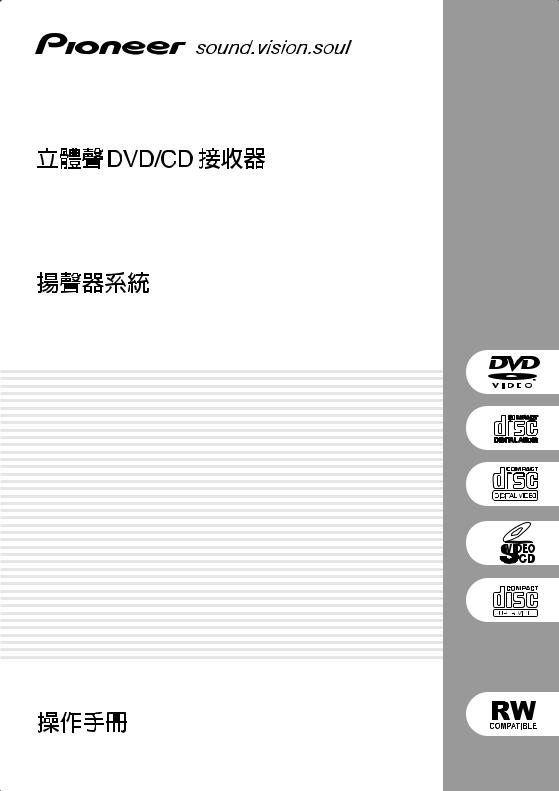
Stereo DVD/CD Receiver
XV-HA5
Speaker System
S-HA5
Operating Instructions
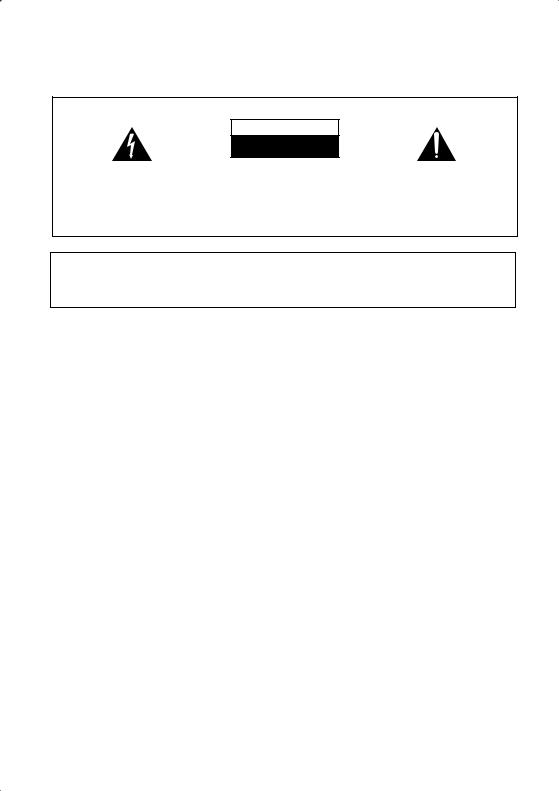
IMPORTANT
CAUTION
RISK OF ELECTRIC SHOCK
DO NOT OPEN
The lightning flash with arrowhead symbol, within an equilateral triangle, is intended to alert the user to the presence of uninsulated "dangerous voltage" within the product's enclosure that may be of sufficient magnitude to constitute a risk of electric shock to persons.
CAUTION:
TO PREVENT THE RISK OF ELECTRIC SHOCK, DO NOT REMOVE COVER (OR BACK). NO USER-SERVICEABLE PARTS INSIDE. REFER SERVICING TO QUALIFIED SERVICE PERSONNEL.
The exclamation point within an equilateral triangle is intended to alert the user to the presence of important operating and maintenance (servicing) instructions in the literature accompanying the appliance.
D3-4-2-1-1_En-A
CAUTION : USE OF CONTROLS OR ADJUSTMENTS OR PERFORMANCE OF PROCEDURES OTHER THAN THOSE SPECIFIED HEREIN MAY RESULT IN HAZARDOUS RADIATION EXPOSURE.
CAUTION : THE USE OF OPTICAL INSTRUMENTS WITH THIS PRODUCT WILL INCREASE EYE HAZARD. D6-8-2-1_En
WARNING
This equipment is not waterproof. To prevent a fire or shock hazard, do not place any container filed with liquid near this equipment (such as a vase or flower pot) or expose it to dripping, splashing, rain or moisture.
WARNING
Before plugging in for the first time, read the following section carefully.
The voltage of the available power supply differs according to country or region. Be sure that the power supply voltage of the area where this unit will be used meets the required voltage (e.g., 230V or 120V) written on the rear panel.
VENTILATION CAUTION
When installing this unit, make sure to leave space around the unit for ventilation to improve heat radiation (at least 10 cm at top, 10 cm at rear, and 10 cm at each side).
WARNING
Slots and openings in the cabinet are provided for ventilation to ensure reliable operation of the product, and to protect it from overheating. To prevent fire hazard, the openings should never be blocked or covered with items (such as newspapers, table-cloths, curtains) or by operating the equipment on thick carpet or a bed.
Operating Environment
Operating environment temperature and humidity: +5 ºC – +35 ºC (+41 ºF – +95 ºF); less than 85 %RH (cooling vents not blocked)
Do not install this unit in a poorly ventilated area, or in locations exposed to high humidity or direct sunlight (or strong artificial light)
CAUTION
These speaker terminals carry HAZARDOUS LIVE voltage. To prevent the risk of electric shock when connecting or disconnecting the speaker cables, disconnect the power cord before touching any uninsulated parts.
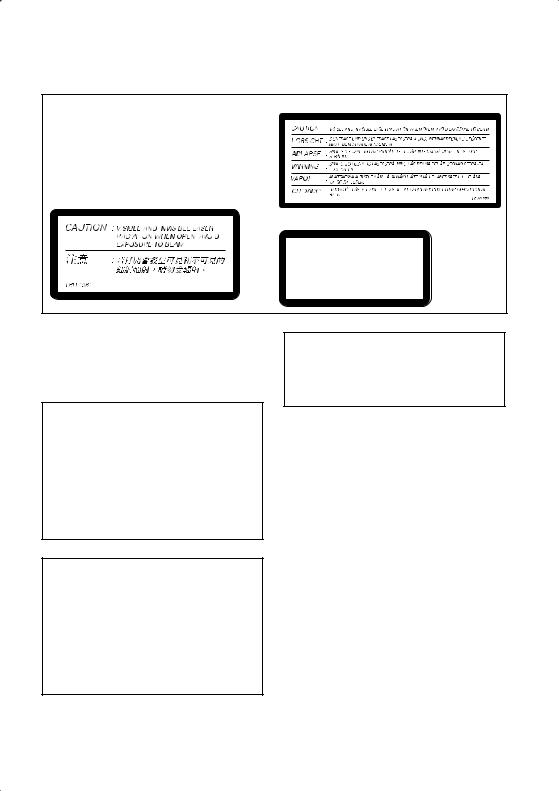
CAUTION |
All other models |
This product is a class 1 laser product, but this product contains a laser diode higher than Class 1. To ensure continued safety, do not remove any covers or attempt to gain access to the inside of the product. Refer all servicing to qualified personnel.
The following caution label appears on your unit.
Location: rear of the unit
Taiwan model
Location: rear of the unit
CLASS 1
LASER PRODUCT
D3-4-2-1-8_A_En
WARNING
To prevent a fire hazard, do not place any naked flame sources (such as a lighted candle) on the equipment.
If the AC plug of this unit does not match the AC outlet you want to use, the plug must be removed and appropriate one fitted. Replacement and mounting of an AC plug on the power supply cord of this unit should be performed only by qualified service personnel. If connected to an AC outlet, the cut-off plug can cause severe electrical shock. Make sure it is properly disposed of after removal.
The equipment should be disconnected by removing the mains plug from the wall socket when left unused for a long period of time (for example, when on vacation).
CAUTION
The STANDBY/ON switch on this unit will not completely shut off all power from the AC outlet. Since the power cord serves as the main disconnect device for the unit, you will need to unplug it from the AC outlet to shut down all power. Therefore, make sure the unit has been installed so that the power cord can be easily unplugged from the AC outlet in case of an accident. To avoid fire hazard, the power cord should also be unplugged from the AC outlet when left unused for a long period of time (for example, when on vacation).
This product is for general household purposes. Any failure due to use for other than household purposes (such as long-term use for business purposes in a restaurant or use in a car or ship) and which requires repair will be charged for even during the warranty period.
POWER-CORD CAUTION
Handle the power cord by the plug. Do not pull out the plug by tugging the cord and never touch the power cord when your hands are wet as this could cause a short circuit or electric shock. Do not place the unit, a piece of furniture, etc., on the power cord, or pinch the cord. Never make a knot in the cord or tie it with other cords. The power cords should be routed such that they are not likely to be stepped on. A damaged power cord can cause a fire or give you an electrical shock. Check the power cord once in a while. When you find it damaged, ask your nearest PIONEER authorized service center or your dealer for a replacement.

Thank you for buying this Pioneer product.
Please read through these operating instructions so that you will know how to operate your model properly. After you have finished reading the instructions, put them in a safe place for future reference.
Contents
01 Before you start
Checking what’s in the box . . . . . . . . . . . . . . . 6
Loading the batteries . . . . . . . . . . . . . . . . . . . 6
Range of the remote control unit . . . . . . . . . . 6 Attaching the non-skid pads . . . . . . . . . . . . . . 6 Removing the speaker grilles . . . . . . . . . . . . 6
02 Connecting up
Making cable connections . . . . . . . . . . . . . . . 7 Connecting the speakers . . . . . . . . . . . . . . . . 7 Connecting the radio antennas. . . . . . . . . . . . 8 Connecting external antennas . . . . . . . . . . . 8
Connecting to your TV. . . . . . . . . . . . . . . . . . . 9
Connecting auxiliary components. . . . . . . . . . 9
Connecting the power. . . . . . . . . . . . . . . . . . . 9
Using the front panel USB connection . . . . . 10
03 Controls and displays
Front panel . . . . . . . . . . . . . . . . . . . . . . . . . . 11 Remote control . . . . . . . . . . . . . . . . . . . . . . . 12 Display . . . . . . . . . . . . . . . . . . . . . . . . . . . . . 14
04 Getting started
Setting the clock . . . . . . . . . . . . . . . . . . . . . . 15
Using the on-screen displays . . . . . . . . . . . . 15
Playing discs . . . . . . . . . . . . . . . . . . . . . . . . 15
Basic playback controls . . . . . . . . . . . . . . . 16 Resume and Last Memory . . . . . . . . . . . . . 16 DVD-Video disc menus. . . . . . . . . . . . . . . . 16 Video CD/Super VCD PBC menus . . . . . . . 17
Listening to the radio . . . . . . . . . . . . . . . . . . 17
Listening to other sources . . . . . . . . . . . . . . 17
05 Playing discs
Scanning discs . . . . . . . . . . . . . . . . . . . . . . . 18
Playing in slow motion . . . . . . . . . . . . . . . . . 18 Frame advance/frame reverse. . . . . . . . . . . . 18 Playing a JPEG slideshow . . . . . . . . . . . . . . . 18 Browsing DVD or Video CD/Super VCD discs with the Disc Navigator. . . . . . . . . . . . . . . . . 19 Browsing WMA, MP3, DivX video and JPEG files with the Disc Navigator . . . . . . . . . . . . . 19 Looping a section of a disc . . . . . . . . . . . . . . 20
Using repeat play . . . . . . . . . . . . . . . . . . . . . 20 Using random play . . . . . . . . . . . . . . . . . . . . 21
Creating a program list . . . . . . . . . . . . . . . . . 21
Using the OSD . . . . . . . . . . . . . . . . . . . . . . 21
Other functions available from the
program menu . . . . . . . . . . . . . . . . . . . . . . 22
Using the front panel display . . . . . . . . . . . 22
Searching a disc . . . . . . . . . . . . . . . . . . . . . . 22 Switching subtitles . . . . . . . . . . . . . . . . . . . . 23
Switching language / audio channels . . . . . . 23
Zooming the screen . . . . . . . . . . . . . . . . . . . 23
Switching camera angles . . . . . . . . . . . . . . . 23 Displaying disc information. . . . . . . . . . . . . . 23
06 More tuner features
Memorizing stations . . . . . . . . . . . . . . . . . . . 24
Manually saving station presets . . . . . . . . . 24 Automatically saving station presets . . . . . 24 Naming station presets. . . . . . . . . . . . . . . . 24 Listening to station presets. . . . . . . . . . . . . 25 Improving poor FM reception . . . . . . . . . . . . 25
07 Singing karaoke
Singing karaoke . . . . . . . . . . . . . . . . . . . . . . 26
Changing the vocal mix . . . . . . . . . . . . . . . 26 Changing the backing track . . . . . . . . . . . . 26
08 Adjusting the sound
Adjusting the bass and treble . . . . . . . . . . . . 27
Using the Quiet mode . . . . . . . . . . . . . . . . . . 27
Boosting the bass level . . . . . . . . . . . . . . . . . 27 Using the Sound Field Control. . . . . . . . . . . . 27
Muting the sound . . . . . . . . . . . . . . . . . . . . . 27
09 Using the timer
Setting the wake-up timer . . . . . . . . . . . . . . . 28 Turning the wake-up timer on/off . . . . . . . . 28 Setting the sleep timer . . . . . . . . . . . . . . . . . 28
10 Audio Settings and Video Adjust menu
Audio Settings menu. . . . . . . . . . . . . . . . . . . 29 Audio DRC . . . . . . . . . . . . . . . . . . . . . . . . . 29 Virtual Surround . . . . . . . . . . . . . . . . . . . . . 29 Video Adjust menu . . . . . . . . . . . . . . . . . . . . 29
4
En

11 Initial Settings menu
Using the Initial Settings menu . . . . . . . . . . . 31 Digital Audio Out settings. . . . . . . . . . . . . . 31 Video Output settings . . . . . . . . . . . . . . . . . 32
Language settings . . . . . . . . . . . . . . . . . . . 32 Display settings . . . . . . . . . . . . . . . . . . . . . 32 Options settings . . . . . . . . . . . . . . . . . . . . . 33 Parental Lock . . . . . . . . . . . . . . . . . . . . . . . 33
About DivX® VOD content . . . . . . . . . . . . . 34
12 Additional information
Optional system settings . . . . . . . . . . . . . . . . 35 System Setup menu options in standby . . . 35
Dimming the display. . . . . . . . . . . . . . . . . . 36
Using and taking care of discs . . . . . . . . . . . 36
DVD Video regions . . . . . . . . . . . . . . . . . . . 36
Disc / content format playback
compatibility . . . . . . . . . . . . . . . . . . . . . . . . . 36
Disc compatibility table . . . . . . . . . . . . . . . 37
About DivX . . . . . . . . . . . . . . . . . . . . . . . . . 37
DivX video compatibility . . . . . . . . . . . . . . . 37
About WMA . . . . . . . . . . . . . . . . . . . . . . . . 38 Handling discs . . . . . . . . . . . . . . . . . . . . . . 38 Storing discs. . . . . . . . . . . . . . . . . . . . . . . . 38 Discs to avoid . . . . . . . . . . . . . . . . . . . . . . . 38
Installation and maintenance . . . . . . . . . . . . 39
Hints on installation . . . . . . . . . . . . . . . . . . 39
Cleaning the pickup lens . . . . . . . . . . . . . . 39 Problems with condensation . . . . . . . . . . . 39 Moving the system unit. . . . . . . . . . . . . . . . 39
Resetting the unit . . . . . . . . . . . . . . . . . . . . . 39 Troubleshooting . . . . . . . . . . . . . . . . . . . . . . 40 General . . . . . . . . . . . . . . . . . . . . . . . . . . . . 40
DVD/CD/Video CD player . . . . . . . . . . . . . . 41
WMA/MP3/JPEG discs . . . . . . . . . . . . . . . . 42 Tuner . . . . . . . . . . . . . . . . . . . . . . . . . . . . . 42
Screen sizes and disc formats. . . . . . . . . . . . 43 Using the language code list . . . . . . . . . . . . . 43
Language code list . . . . . . . . . . . . . . . . . . . . 44
Country/Area code list . . . . . . . . . . . . . . . . . . 44
Specifications . . . . . . . . . . . . . . . . . . . . . . . . 45
Español Nederlands Italiano Français Deutsch English
5
En
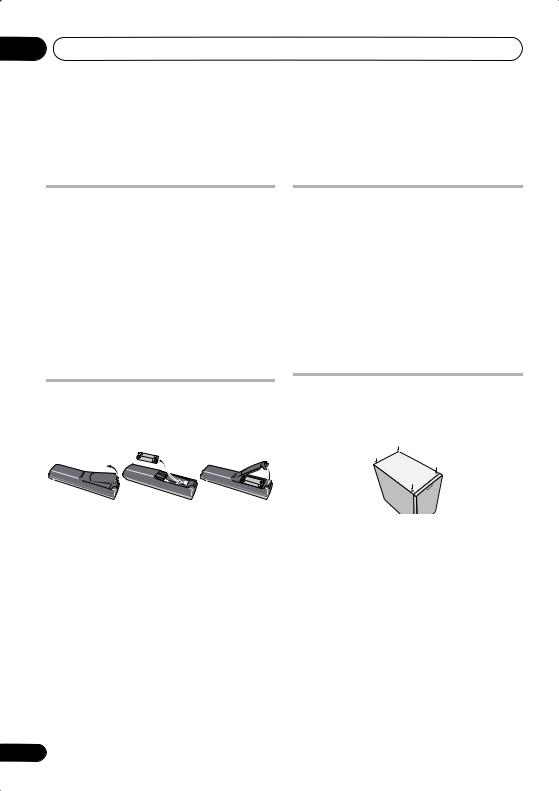
01 Before you start
Chapter 1
Before you start
Checking what’s in the box |
Range of the remote control unit |
Please check that you've received the following supplied accessories:
•Remote control
•Dry cell batteries (AA/R6) x2
•Video cable
•AM loop antenna
•FM antenna
•Power cord
•Non-skid pads
•These operating instructions
The remote control has a range of about 7 meters. It may not work properly if:
•There are obstacles between the remote control and this unit’s remote sensor.
•Direct sunlight or fluorescent light is shining onto the remote sensor.
•This system is located near a device that is emitting infrared rays.
•This unit is operated simultaneously with another infrared remote control unit.
Loading the batteries
Use AA/R6 batteries with the supplied remote control. Make sure to follow the indications ( ,
) inside the compartment.
 Important
Important
Incorrect use of batteries may result in such hazards as leakage and bursting. Observe the following precautions:
•Never use new and old batteries together.
•Insert the plus and minus sides of the batteries properly according to the marks in the battery case.
•Batteries with the same shape may have different voltages. Do not use different batteries together.
•When disposing of used batteries, please comply with governmental regulations or environmental public instruction’s rules that apply in your country or area.
6
Attaching the non-skid pads
Use the self-adhesive non-skid pads to provide a stable base for the speakers. Attach four to each speaker as shown below.
Removing the speaker grilles
If necessary, the speaker grilles can be removed as described below.
1Gently ease the grille loose by gripping the bottom and pulling towards you.
2Pull the top free in the same way.
When reattaching, start from the top then push the bottom in until secure.
•It is not recommended (due to dirt and dust) to leave the speaker grilles removed.
•Since the speaker grilles may come loose, make sure to place the speakers in a location where they will not cause injury.
En
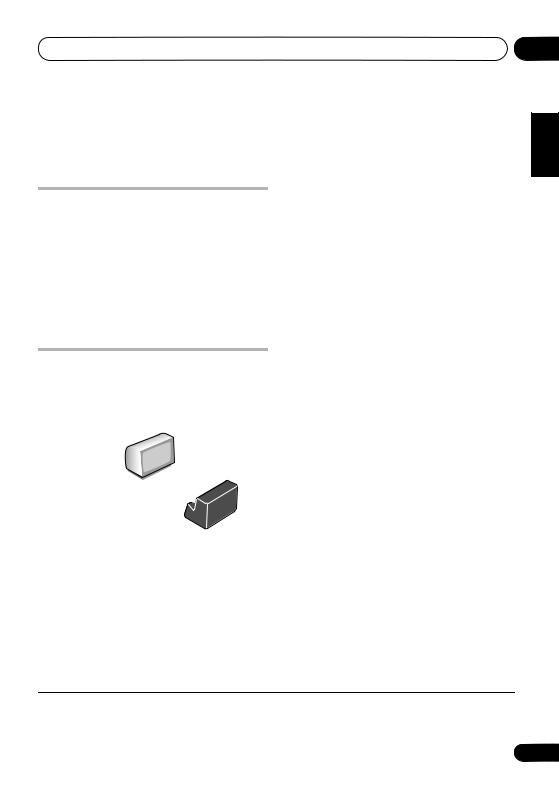
Connecting up
Chapter 2
Connecting up
Making cable connections
Make sure not to bend the cables over the top of this unit. This may cause a humming noise from the speakers.
 Important
Important
•Before making or changing any connections, switch off the power and unplug the power cord from the AC outlet.
Connecting the speakers
Place the front left and right speakers at equal distances from the TV, then connect them as
shown below.1
Right speaker
Left  speaker
speaker 
Listening position
 Caution
Caution
•Do not attach these speakers to the wall or ceiling. They could fall and cause injury.
1Twist and pull off the protective shields on each wire.
2Connect to the speaker terminals on the rear of the unit.
Make sure to insert the striped wire into the red
(+) tab and the white wire into the black (–) tab.
•Do not connect this speaker to any amplifier other than the one supplied with this system. Connection to any other amplifier may result in a malfunction or fire.
•Make sure that the bare speaker wires cannot touch each other, or come into contact with other metal parts once the unit is switched on.
 Note
Note
1 These speakers are magnetically shielded. However, depending on the installation location, color distortion may occur if the speaker system is installed extremely close to the screen of a television set. If this happens, turn off the television set, and then turn it on after 15 to 30 minutes. If the problem persists, move the speaker system away from the television set.
02
Español Nederlands Italiano Français Deutsch English
7
En
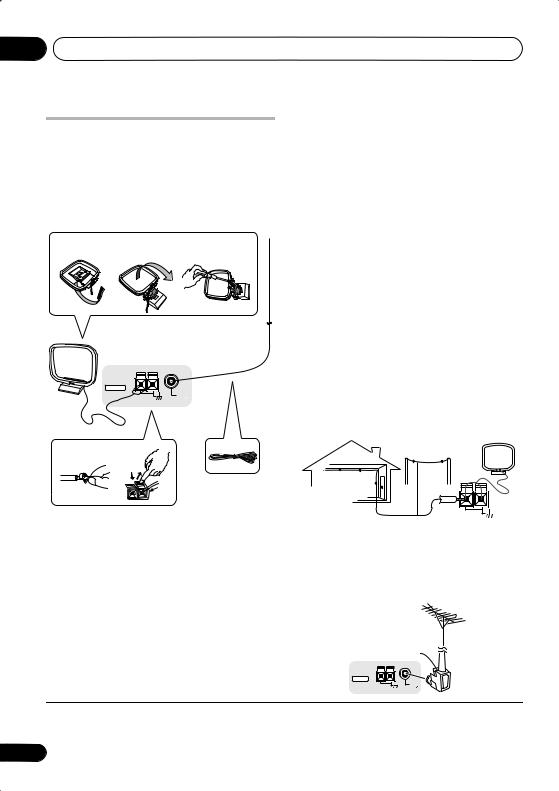
02 Connecting up
Connecting the radio antennas
Connecting the supplied antennas will allow you to listen to both AM and FM radio broadcasts. If you find that reception quality is poor, an outdoor antenna should give you better sound quality—see Connecting external antennas below for more on how to do this.
fig. a |
fig. b |
fig. c |
3
5
|
ANTENNA |
|
4 |
AM |
FM |
LOOP ANTENNA |
UNBAL 75 |
1 |
2 |
1Pull off the protective shields of both AM antenna wires.
2Push open the tabs, then insert one wire fully into each terminal, then release the tabs to secure the AM antenna wires.
3Fix the AM loop antenna to the attached stand.
To fix the stand to the antenna, bend in the direction indicated by the arrow (fig. a) then clip the loop onto the stand (fig. b).
•If you plan to mount the AM antenna to a wall or other surface, secure the stand with screws (fig. c) before clipping the loop to the stand. Make sure the reception is clear.
4 Place the AM antenna on a flat surface and point in the direction giving the best reception.
Don’t let it come into contact with metal objects and avoid placing near computers,
television sets or other electrical appliances.1
5 Connect the FM wire antenna in the same way as the AM loop antenna.
For best results, extend the FM antenna fully and fix to a wall or door frame. Don’t drape loosely or leave coiled up.
Connecting external antennas
External AM antenna
Use 5–6 meters of vinyl-insulated wire and set up either indoors or outdoors. Leave the AM loop antenna connected.
|
Outdoor antenna |
|
Indoor |
|
|
antenna |
|
|
(vinyl-coated |
AM |
|
wire) |
LOOP ANTENNA |
|
5–6m (15–18 ft.) |
||
|
External FM antenna
Use a PAL connector to hook up an external FM antenna.
PAL connector |
|
ANTENNA |
|
AM |
FM |
LOOP ANTENNA |
UNBAL 75 |
 Note
Note
1 The signal ground ( ) is designed to reduce noise that occurs when an antenna is connected. It is not an electrical safety ground.
8
En
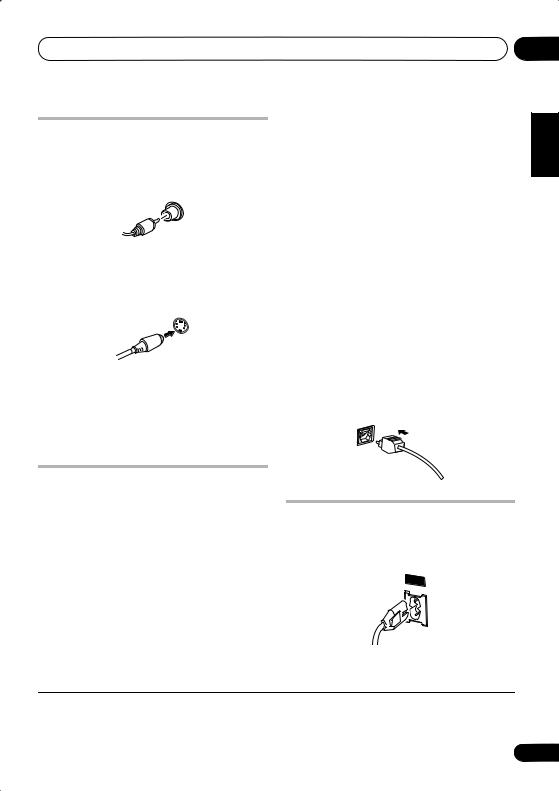
Connecting up
Connecting to your TV
1 Connect the VIDEO OUT jack to a video input on your TV.
Use the supplied yellow video cable.
VIDEO
OUT
For a better image, you can also use a commercially available S-Video cable to connect the S-VIDEO OUT jack to an S-Video input on your TV.
•Connect the LINE OUT jacks on the rear panel to a recording component.
These include components such as a cassette deck, VCR, MD recorder, or another recorder with analog inputs. Connect using RCA pinplug stereo cables.
•Connect the front panel F.AUDIO INPUT mini-plug jack to an auxiliary playback component.
These include components such as an MD player or the analog audio output of a personal
computer. Connect using a 1/4” stereo miniplug cable.1
S-VIDEO
OUT
2 Optionally: Use a stereo audio cable to connect the audio outs of your TV (or VCR) to the LINE IN jacks on the rear of this unit.
This will enable you to hear the TV (or VCR) sound through this system. See Connecting auxiliary components below for more on this.
Connecting auxiliary components
This system has an optical digital output as well as both stereo analog inputs and outputs. You can use the optical digital output to listen to multichannel sound from an external receiver, or to connect to a digital recorder. Use the analog connections for other external components with analog connections.
See Using the front panel USB connection below to connect the front panel USB INPUT.
• Connect the LINE IN jacks on the rear panel to an auxiliary playback component.
These include components such as a VCR, MD player, or your TV. Connect using RCA pin-plug stereo cables.
 Note
Note
• Connect the DVD/CD OPTICAL OUT jack on the rear panel to the optical input of an
external receiver or digital recorder.2
See Digital Audio Out settings on page 31 if you need to switch the digital output options to match your setup. Refer to the manual that came with your receiver or digital recorder for proper setup instructions.
Connecting the power
After making sure that everything is connected properly, plug in the power cord to the AC inlet, and the other end to a mains power outlet.
AC IN
Congratulations! You’re done setting up.
1The system automatically switches the input to F. Audio In when you connect a mini-jack cable to the front panel.
2When inserting the plug, the protective shutter will open and you should hear the plug click into position when fully inserted. Take care not to force the plug as this may damage the shutter, the cable and/or the player.
02
Español Nederlands Italiano Français Deutsch English
9
En

02 Connecting up
Using the front panel USB connection
It is possible to listen to audio sources from your computer by connecting to the USB interface on the front panel. Depending on your model of computer and the software installed, you can listen to any source compatible with your operating system
through this system.1
1Connect the USB terminal on the front panel to the USB terminal of a laptop or PC.
2Switch on your computer and this unit.
If you're connecting for the first time, wait for the USB driver installation to finish.
The installation may take a minute or two to complete. Make sure you leave the USB cable connected until the dialog box indicates that the USB setup is finished. Note that some older operating systems may require a disc for installation.
3 Press INPUT repeatedly until USB shows in the front panel display.
Make any necessary settings required to select the USB interface as your computer audio output (you may need to access your speaker settings from the Control Panel of your operating system).
You will also need to make sure the correct speaker setting is selected with the audio software you're using. Please refer to the manual that came with the software to make these settings.
4Turn up the volume control on your computer and this unit.
You may want to start with a fairly low volume on this unit and turn it up as necessary after you've checked your levels.
5Start playback of a source on your computer.
 Caution
Caution
•Make sure you don't switch off the computer or unplug the USB cable during playback.
•To prevent noise being output, don't use other software on your computer during playback.
•Pioneer is not responsible for computer system damage, software crashes or failures, or any other possible computer problems due to this configuration.
Microsoft Windows® XP, Windows® 2000, Windows® Millennium Edition, Windows® NT
and Windows® 98 Second Edition are registered trademarks of Microsoft Corporation, Inc.
 Note
Note
1 • Windows®XP, Windows® 2000, Windows® Millennium Edition and Windows® 98 Second Edition operating systems have been tested for compatibility, but depending on your computer setup, you may find that your system is not compatible.
•The USB cable must connect from an A-type connector (from your PC) to a 4-pin B-type connector (to this unit).
•The USB specification is version 1.1 compatible, and the USB Audio Class specification is 1.0 compatible.
•You won't be able to control this unit using your computer (and vice-versa).
•Sampling formats up to 48kHz can be heard using the USB connection (formats above 48kHz must be downsampled).
•Any computer alert sounds will also be heard unless you switch them off from the computer's control panel.
•You won't be able to hear the audio from the USB connection through the digital output of this system.
•Even when this unit is switched off, it will remain selected in your speaker settings.
•Note that using hubs or extensions may cause connection problems.
10
En
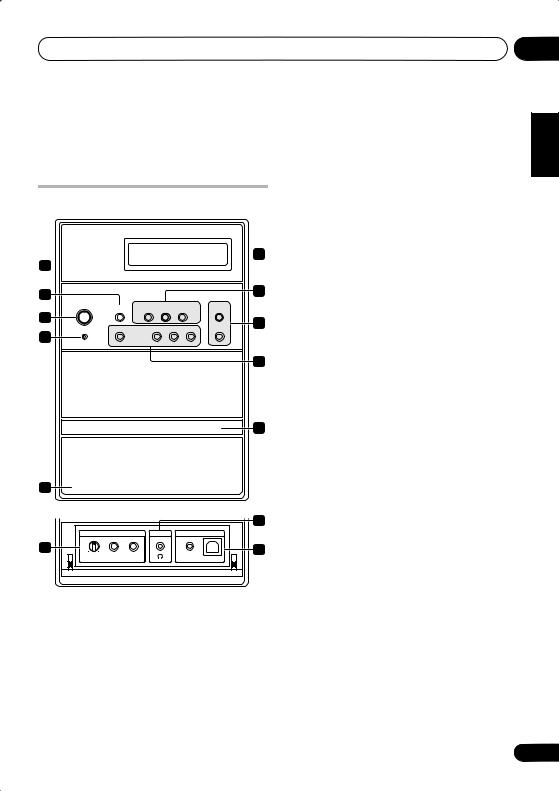
Controls and displays
Chapter 3
Controls and displays
Front panel



 6 1
6 1 
2 |
|
|
|
|
|
7 |
|
|
|
|
|
|
|
|
STANDBY/ON |
KARAOKE |
DVD/CD INPUT |
FM/AM |
VOLUME |
|
3 |
|
|
|
|
+ |
8 |
|
TIMER |
DVD/CD |
|
|
|
|
4 |
|
|
|
|
– |
|
|
|
|
|
|
|
9 |
|
|
|
|
STEREO DVD RECEIVER HA5DVD |
|
|
|
|
|
|
|
|
10 |
5 |
PUSH OPEN |
|
|
|
|
|
|
|
|
|
|
|
12 |
|
|
MIC |
PHONES |
INPUT |
|
|
11 |
MIN |
MAX |
|
|
|
13 |
|
VOL |
MAIN |
SUB |
F. AUDIO |
USB |
|
1Remote sensor
2KARAOKE
Selects audio channels for karaoke (page 26).
3 STANDBY/ON
Switches the player on or into standby.
4 TIMER indicator
Lights when the timer has been set.
5 PUSH OPEN
Pressing down on this side of the door will open the control panel.
6 SYSTEM DISPLAY
Switches between information and clock displays (page 15), (page 23).
7 Function select buttons
Selects the source you want to listen to (INPUT cycles through the auxiliary inputs).
8VOLUME +/–
Adjusts the volume level.
9DVD/CD playback controls
DVD/CD
Opens/closes the disc tray.
Jumps to the next chapter or track.
Jumps to the beginning of the current chapter or track, then to previous chapters/ tracks.
Stops playback.
10Disc tray
11MIC VOL and MIC input jacks
Controls the volume of the karaoke mics (MAIN and SUB).
12PHONES jack
Headphone jack.
13INPUT
Connect an auxiliary component using a USB cable or a stereo mini-jack cable.
03
Español Nederlands Italiano Français Deutsch English
11
En

03 Controls and displays
Remote control
STANDBY/ON
1
2 |
FUNCTION |
|
DVD/CD |
|
DVD/CD |
FM/AM |
INPUT |
|
|
3 |
BASS |
TIMER/ |
|
SYSTEM |
|
|
|||
|
BOOST |
CLOCK ADJ. |
|
SETUP |
|
VIRTUAL |
|
DVD |
|
4 |
SURROUND SFC |
AUDIO |
SUBTITLE |
|
|
|
|
|
|
|
MUTE |
SOUND |
ANGLE |
ZOOM |
5 |
|
VOLUME |
|
|
6 |
TOP MENU |
|
|
DVD MENU |
|
TUNE + |
|
||
|
|
|
||
7 |
ST – |
ENTER |
ST + |
|
|
|
|||
|
HOME |
|
|
RETURN |
|
MENU |
TUNE – |
||
8 |
|
|
||
|
|
|
|
|
|
1 |
3 |
|
¡ |
9 |
|
|
|
|
|
4 |
8 |
7 |
¢ |
|
1 |
ABC |
DEF |
|
|
2 |
3 |
CLEAR |
|
10 |
GHI |
JKL |
MNO |
|
4 |
5 |
6 |
ENTER |
|
|
PQRS |
TUV |
WXYZ |
MARK |
|
7 |
8 |
9 |
0 |
11 |
REPEAT RANDOM PROGRAM DISP/CHARA |
|||
|
|
|
|
|
12 |
KARAOKE |
ECHO |
KEY CONTROL |
|
|
|
|
|
|
13
14
15
16
17
4Sound control buttons
BASS BOOST
Switches the bass boost on or off (page 27).
VIRTUAL SURROUND
Switches the Virtual Surround effect on or off (page 29).
SFC
Selects sound modes from the Sound Field Control (page 27).
MUTE
Mutes the volume (page 27).
SOUND
Accesses settings in the Sound menu, such as the tone controls (page 27).
5VOLUME
Adjusts the volume level.
6 TOP MENU
Displays the top menu of a DVD disc.
7ENTER, TUNE & cursor control buttons
Navigates on-screen displays and menus. ENTER selects an option or executes a command.
8HOME MENU
Press to display (or exit) the on-screen menu for Initial Settings, Play Mode functions, etc.
9 Playback controls
1 STANDBY/ON
Switches the player on or into standby.
2 FUNCTION buttons
Selects the source you want to listen to (INPUT cycles through the auxiliary inputs).
3 TIMER/CLOCK ADJ.
Use for setting the clock (page 15), as well as for setting and checking the timers (page 28).
Starts/resumes playback.
Use for reverse / forward scanning.
Jumps to the next chapter or track.
Jumps to the beginning of the current chapter or track, then to previous chapters/ tracks.
12
En

Controls and displays |
03 |
Pauses playback; press again to restart.
Stops playback.
10 Number/character buttons
The number buttons can be used for selecting tracks directly, or for selecting items from an on-screen menu.
CLEAR
Clears an entry.
ENTER
Selects menu options, etc. (works exactly the same as the ENTER button in 7 above).
11REPEAT
Selects a repeat play mode (page 20).
RANDOM
Selects a random play mode (page 21).
PROGRAM
Use to program/play a program list (page 21).
DISP/CHARA
Switches between information in the display (page 23) and between uppercase and lowercase letters when naming radio station presets (page 24).
12KARAOKE controls
KARAOKE
Selects audio channels for karaoke (page 26).
ECHO
Changes the echo level on the karaoke mics (page 26).
KEY CONTROL
Lowers/raises the pitch of the backing track (page 26).
13DVD/CD
Opens/closes the disc tray.
14 SYSTEM SETUP
Use to make various system settings.
15DVD control buttons
AUDIO
Selects the audio channel or language (page 23).
SUBTITLE
Selects a subtitle display (page 23).
ANGLE
Changes the camera angle during DVD multi-angle scene playback (page 23).
ZOOM
Changes the zoom level (page 23).
16DVD MENU
Displays the DVD menu (for Video CD/Super VCDs, DivX video and WMA/MP3/JPEG discs, the Disc Navigator screen appears).
17 RETURN
Press to return to a previous menu screen.
Español Nederlands Italiano Français Deutsch English
13
En
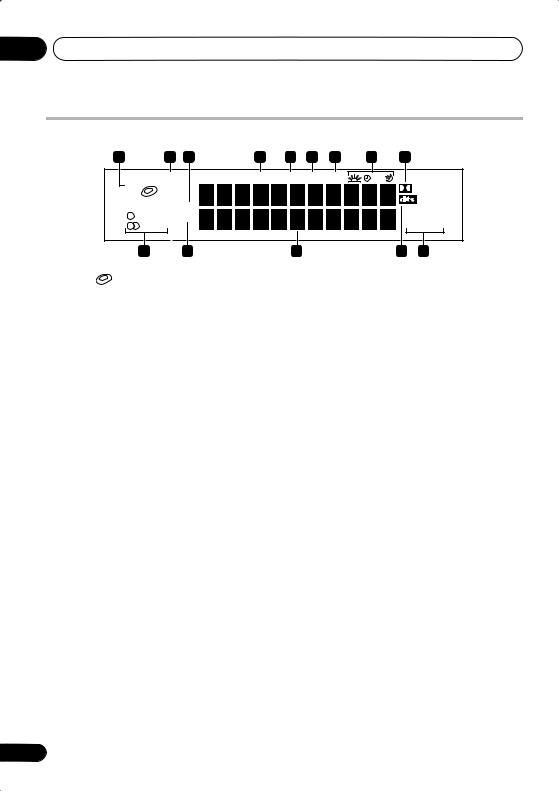
03 Controls and displays
Display
1 |
2 |
3 |
4 |
5 |
6 |
7 |
8 |
9 |
|
ANGLE |
V.SURROUND BB RPT – 1 PGM |
|
DIGITAL |
||||
|
DISC |
|
|
|
|
|
|
|
|
|
|
|
|
|
|
|
|
|
|
TONE |
|
|
|
|
|
L R |
|
|
RDM |
|
|
|
|
|
ECHO KEY |
|
TUNED |
|
|
|
|
|
|
KARAOKE |
|
10 |
11 |
1 DISC ( |
) |
|
Lights when a disc is loaded in the disc tray.
2 ANGLE
Lights during multi-angle scenes on a DVD disc.
3 TONE
Lights when the bass or treble has been adjusted.
4 V.SURROUND
Lights when Virtual Surround is switched on.
5 BB
Lights when the bass boost is switched on.
6 RPT-1
RPT lights during repeat play (RPT-1 lights during repeat one-track play).
7 PGM
Lights during program play.
8Timer indicators
 – Lights when the wake-up timer is set.
– Lights when the wake-up timer is set.
 – Lights when the wake-up timer is set and flashes when it activates.
– Lights when the wake-up timer is set and flashes when it activates.
 – Lights when the sleep timer is active.
– Lights when the sleep timer is active.
92 DIGITAL
Lights during playback of a Dolby Digital signal.
10 Tuner indicators
12 |
13 |
14 |
 – Lights when a stereo FM broadcast is being received in auto stereo mode.
– Lights when a stereo FM broadcast is being received in auto stereo mode.
 – Lights when FM mono reception is selected.
– Lights when FM mono reception is selected.
11 RDM
Lights during random playback.
12Character display
13DTS
Lights during playback of a DTS source.
14Karaoke indicators
KARAOKE (Vocal cancel) – Vocals in the backing track are partially eliminated using EQ.
L – Left channel only. Use for tracks that have a vocal recorded in the right channel.
R – Right channel only. Use for tracks that have a vocal recorded in the left channel.
L R – Use to put a single-channel vocal track into the center of the mix.
KEY – Lights when the Karaoke pitch control is selected.
ECHO – Lights when the Karaoke ECHO effect is selected.
TUNED – Lights when a broadcast is being received.
14
En
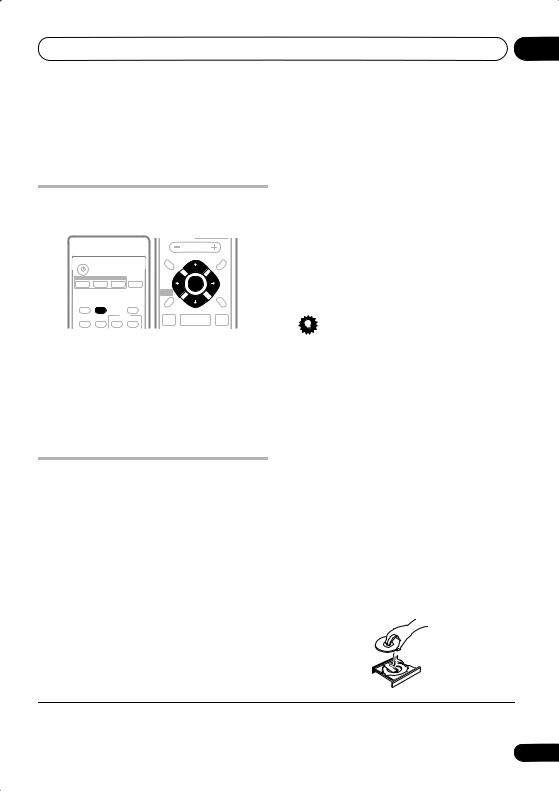
Getting started
Chapter 4
Getting started
Setting the clock
Setting the clock allows you to use the timer.1
|
|
|
|
VOLUME |
|
STANDBY/ON |
|
TOP MENU |
|
DVD MENU |
|
|
|
|
|
||
|
|
|
|
TUNE + |
|
FUNCTION |
DVD/CD |
ST – |
|
ST + |
|
DVD/CD |
FM/AM |
INPUT |
|
ENTER |
|
|
|
|
HOME |
|
RETURN |
|
|
|
MENU |
TUNE – |
|
BASS |
TIMER/ |
SYSTEM |
|
|
|
|
|
|
|||
BOOST CLOCK ADJ. |
SETUP |
|
|
|
|
VIRTUAL |
|
DVD |
|
|
|
SURROUND |
SFC |
AUDIO SUBTITLE |
1 |
3 |
¡ |
1Press TIMER/CLOCK ADJ.
2If ‘Clock ADJ’ isn’t in the display, select it with or , then press ENTER.
3Use / to set the hour. Press ENTER.
4Use / to set the minute then press
ENTER to confirm.
Using the on-screen displays
For ease of use, this system makes extensive use of graphical on-screen displays (OSDs).
All the screens are navigated in basically the same way, using the cursor buttons ( , , ,) to change the highlighted item and
pressing ENTER to select it.2
 Important
Important
•Throughout this manual, ‘Select’ means use the cursor buttons to highlight an item on-screen, then press ENTER.
04
|
|
|
|
|
|
|
|
English |
|
|
|
|
|
|
|
|
|
|
|
|
|
|
|
|
|
|
|||
|
Button |
What it does |
|
|
|
||||
|
Deutsch |
||||||||
|
|
|
|
|
|
||||
|
Changes the highlighted menu item |
|
|||||||
|
HOME |
Displays/exits the on-screen display |
|
|
|||||
|
MENU |
|
|
|
|
|
|||
|
|
|
|
|
|
|
|
||
|
ENTER |
Selects the highlighted menu item |
|
|
|||||
|
|
|
|
|
|
|
|
Français |
|
|
RETURN |
Returns to the main menu without |
|||||||
|
|
||||||||
|
|
|
|
saving changes |
|
||||
|
|
|
|
|
|
|
|
|
|
|
|
|
Tip |
|
|
|
|
|
|
|
|
|
|
|
|
|
|
||
|
|
|
|
|
|||||
|
• The button guide at the bottom of every |
|
|||||||
Italiano |
|||||||||
|
|
OSD screen shows you which buttons |
|||||||
|
|
|
|||||||
|
|
you’ll need to use for that screen. |
|
||||||
|
|
|
|
|
|||||
|
Playing discs |
|
|
||||||
Nederlands |
|||||||||
|
|
|
|
|
|
|
|
||
The basic playback controls for playing DVD, CD, Video CD/Super VCD, DivX video and MP3/ WMA/JPEG discs are covered here. Further functions are detailed in chapter 5.
1 If the player isn’t already on, switch it on.
If you’re playing a DVD or Video CD/Super VCD, |
Español |
|||
also turn on your TV and make sure that it is set |
||||
|
||||
to the correct video input. |
|
|||
2 Press DVD/CD to load a disc. |
|
|||
Load a disc with the label side facing up, using |
|
|||
the disc tray guide to align the disc (if you’re |
|
|||
loading a double-sided DVD disc, load it with |
|
|||
the side you want to play face down). |
|
|||
|
|
|
|
|
|
|
|
|
|
 Note
Note
1The default setting is 12-hour format. See Optional system settings on page 35 to change it.
2The screen saver will appear after five minutes of inactivity.
15
En

04 Getting started
3 Press (play) to start playback.
If you’re playing a DVD or Video CD/Super VCD, a menu may appear. See DVD-Video disc menus on page 16 and Video CD/Super VCD PBC menus on page 17 to navigate these.
If you’re playing a DivX video or WMA/MP3 disc, it may take a few seconds before playing.
If you loaded a CD/CD-R/RW containing JPEGs, a slideshow will start. See Playing a JPEG slideshow on page 18 for more on this.
•If a disc contains a mixture of DivX video and other media file types (MP3, for example), first select whether to play the DivX video files (DivX) or the other media file types (MP3 / WMA / JPEG) from the onscreen display.
4 Adjust the volume.
Use the VOLUME control.
Basic playback controls
The following table shows the basic controls on
the remote for playing discs1. You can find other playback features in chapter 5.
Button What it does
Numbers Use to enter a title/chapter/track number. Press ENTER to select.
•If the disc is stopped, playback starts from the selected title (for DVD) or track (for CD/Video CD/Super VCD).
•If the disc is playing, playback jumps to the start of the selected title (VR mode DVD-RW), chapter (DVD-Video) or track (CD/Video CD/Super VCD).
Resume and Last Memory
When you stop playback of a disc, Resume shows in the display indicating that you can resume playback from that point.
With DVDs and Video CD/Super VCDs, even if
ejected, the play position is stored in memory.2 The next time you load the disc, the display shows Last Mem and you can resume playback.
If you want to clear the resume point, press (stop) while Resume is displayed.
DVD-Video disc menus
Button What it does
Starts/resumes normal playback.
• If the display shows Resume or Last Mem playback starts from the resume or last memory point (see Resume and Last Memory below).
Pauses/unpauses a disc.
Stops playback or cancels the resume function (if the display shows Resume).
Press to start fast reverse scanning.
Press to start fast forward scanning.
Skips to the start of the current track or chapter, then previous tracks/chapters.
Skips to the next track or chapter.
Many DVD-Video discs contain menus from which you can select what you want to watch.
Sometimes DVD-Video menus are displayed automatically when you start playback; others only appear when you press DVD MENU or
TOP MENU.
Button |
What it does |
TOP MENU Displays the ‘top menu’ of a DVD disc—this varies with the disc.
DVD |
Displays a DVD disc menu—this |
MENU |
varies with the disc and may be |
|
the same as the ‘top menu’. |
|
|
|
Moves the cursor around the |
|
screen. |
|
|
 Note
Note
1You may find with some DVD discs that some playback controls don’t work in certain parts of the disc.
2• The Last Memory function may not work with some discs.
• For DVD-Video discs (except VR mode DVD-RW), the player stores the play position of the last five discs.
16
En
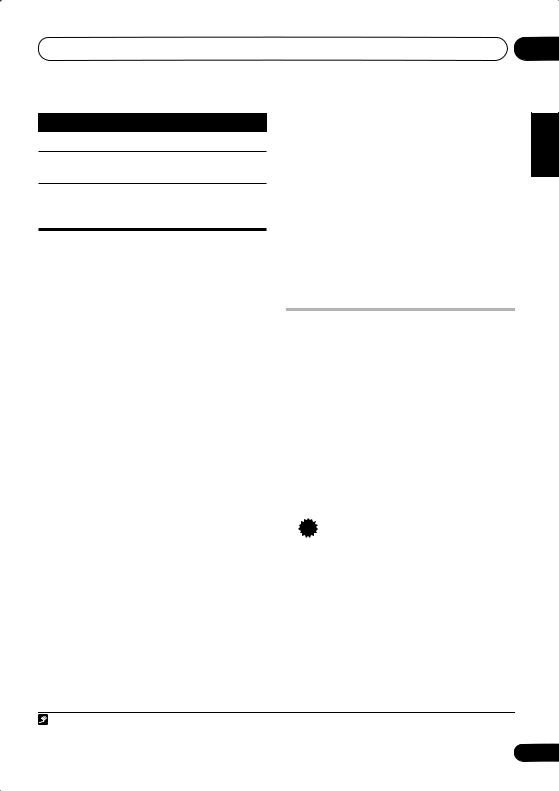
Getting started |
04 |
Button |
What it does |
ENTER Selects the current menu option.
RETURN Returns to the previously displayed menu screen.
Numbers Highlights a numbered menu option (some discs only). Press ENTER to select.
Video CD/Super VCD PBC menus
Some Video CD/Super VCDs have menus from which you can choose what you want to watch. These are PBC (Playback control) menus.
You can play a PBC Video CD/Super VCD without having to navigate the PBC menu by starting playback using a number button to select a track, rather than the (play) button.
Button |
What it does |
|
RETURN |
Displays the PBC menu. |
|
|
|
|
Numbers |
Selects numbered menu options. |
|
|
Press ENTER to select. |
|
|
|
|
|
Displays the previous menu page |
|
|
(if there is one). |
|
|
|
|
|
Displays the next menu page (if |
|
|
there is one). |
|
|
|
|
|
|
|
Listening to the radio
The tuner can receive both FM and AM broadcasts, and lets you memorize your favorite stations so you don’t have to manually tune in every time you want to listen (see More tuner features on page 24 for more on this).
1Press FM/AM to switch to the tuner, then press repeatedly to select the AM or FM band.
The display shows the band and frequency.
2Tune to a frequency.
There are three tuning modes—manual, auto, and high-speed:
•Manual tuning: Press TUNE +/– repeatedly to change the displayed frequency.
•Auto tuning: Press and hold TUNE +/– until the frequency display starts to move, then release. The tuner will stop on the next station it finds. Repeat to keep searching.
•High-speed tuning: Press and hold TUNE +/– until the frequency display starts to move rapidly. Keep the button held down until you reach the frequency you want. If necessary, fine tune the frequency using the manual tuning method.
Listening to other sources
You can connect up to three external sources (TV, satellite receiver, PC, etc.) to this system,
including one USB connection.1 See also
Connecting auxiliary components on page 9.
1Make sure that the external source (TV, satellite receiver, etc.) is switched on.
2Select the source you want to listen to.
Press INPUT to select the front panel audio input (F. Audio In), the rear panel audio input (Line), or the front panel USB jack (USB).
3If necessary, start playback of the source.
 Tip
Tip
•If an auxiliary source is producing unpleasant distortion from the speakers, you can reduce the signal level (connected to the F. Audio In or Line analog inputs) by switching on the attenuator. See Front Audio / Line attenuator settings on page 36 to do this.
Español Nederlands Italiano Français Deutsch English
 Note
Note
1 See Using the front panel USB connection on page 10 for more on this.
17
En

05 Playing discs
Chapter 5
Playing discs
 Important
Important
•Many of the functions covered in this chapter apply to DVD discs, Video CDs/ Super VCDs, CDs, DivX video and WMA/ MP3/JPEG discs, although the exact operation of some varies slightly with the kind of disc loaded.
•Some DVDs restrict the use of some functions (random or repeat, for example) in some or all parts of the disc. This is not a malfunction.
•When playing Video CD/Super VCDs, some of the functions are not available during PBC playback. If you want to use them, start the disc playing using a number button to select a track.
1 |
During playback, press |
(pause). |
|
2 |
Press and hold |
or |
until slow |
motion playback starts. |
|
||
Press repeatedly to change the slow motion speed (shown on-screen).
• To resume playback, press (play).2
Frame advance/frame reverse
You can advance or back up DVD discs frame- by-frame. With Video CD/Super VCDs and DivX video you can only use frame advance.
1 |
During playback, press (pause). |
||
2 |
Press |
or |
to reverse or advance a |
frame at a time. |
|
||
• To resume playback, press (play).2
Scanning discs
You can fast-scan discs forward or backward at various different speeds.1
• During playback, press |
or |
to start |
scanning. |
|
|
Press repeatedly to increase the scanning speed (shown on-screen).
• To resume playback, press (play).2
Playing a JPEG slideshow
After loading a CD/CD-R/RW containing JPEG pictures, press to start a slideshow from the
first folder/picture on the disc.3 The player displays the pictures in each folder in alphabetical order.
Pictures are automatically adjusted so that they fill as much of the screen as possible.
While the slideshow is running:
Playing in slow motion
Button |
What it does |
You can play DVDs, Video CD/Super VCDs and DivX video at four different forward slow motion speeds. DVD discs can also be played in reverse slow motion.
Pauses the slideshow; press again to restart.
Displays the previous picture.
 Note
Note
1Only one speed is available for DivX video discs.
2• Depending on the disc, normal playback may automatically resume when a new chapter is reached on a DVD disc.
•With Video CD/Super VCDs in PBC mode or a WMA/MP3 track, playback automatically resumes at the end or beginning of the track.
3• The time it takes for the player to load a file increases with large file sizes.
18
En
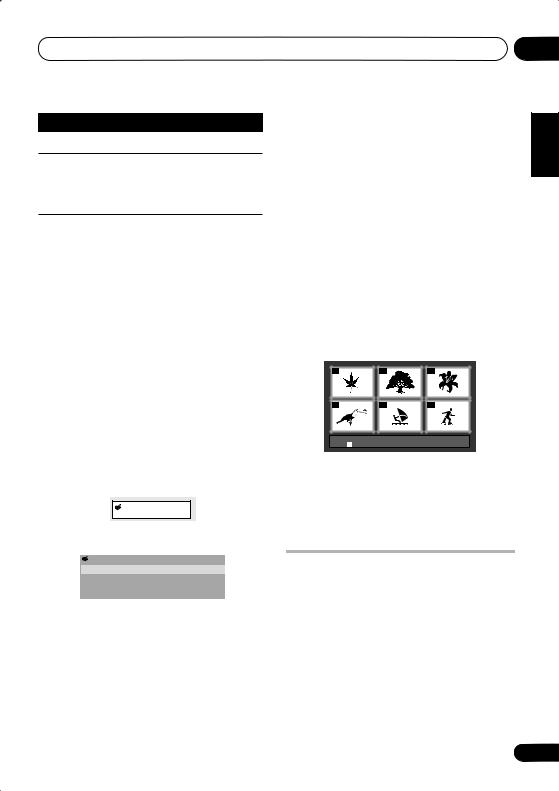
Playing discs |
05 |
Button |
What it does |
|
Displays the next picture. |
/ / / Pauses the slideshow and rotates/flips the displayed picture. (Press (play) to restart slideshow).
ZOOM |
Pauses the slideshow and zooms |
|
|
the picture. Press again to toggle |
|
|
between 1x, 2x and 4x zoom. |
|
|
(Press (play) to restart |
|
|
slideshow). |
|
|
|
|
DVD |
Displays the Disc Navigator |
|
MENU |
screen (see below). |
|
|
|
|
|
|
|
Browsing DVD or Video CD/ Super VCD discs with the Disc Navigator
Use the Disc Navigator to browse through the contents of a DVD or Video CD/Super VCD disc to find the part you want to play.
1 During playback, press HOME MENU and select ‘Disc Navigator’ from the onscreen menu.
 Disc Navigator
Disc Navigator
2 Select a view option.
 Disc Navigator
Disc Navigator
Title
Chapter
The options available depend on the kind of disc loaded and whether the disc is playing or not, but include:
•Title – Titles from a DVD-Video disc.
•Chapter – Chapters from the current title of a DVD-Video disc.
•Track – Tracks from a Video CD/Super VCD disc.
•Time – Thumbnails from a Video CD/Super VCD disc at 10 minute intervals.
•Original: Title – Original titles from a VR mode DVD-RW disc.
•Playlist: Title – Playlist titles from a VR mode DVD-RW disc.
•Original: Time – Thumbnails from the Original content at 10 minute intervals.
•Playlist: Time – Thumbnails from the Playlist at 10 minute intervals.
The screen shows up to six moving thumbnail images displayed one after another. To display the previous/next six thumbnails, press /
.
3 Select the thumbnail image for what you want to play.
01 |
02 |
03 |
04 |
05 |
06 |
Disc Navigator: Title 0149: --
You can use either the cursor buttons (/ / /) and ENTER to select a thumbnail, or the number buttons.
To select using the number buttons, enter a two-digit number then press ENTER.
Browsing WMA, MP3, DivX video and JPEG files with the Disc Navigator
Use the Disc Navigator to find a particular file or folder by filename.
Español Nederlands Italiano Français Deutsch English
19
En
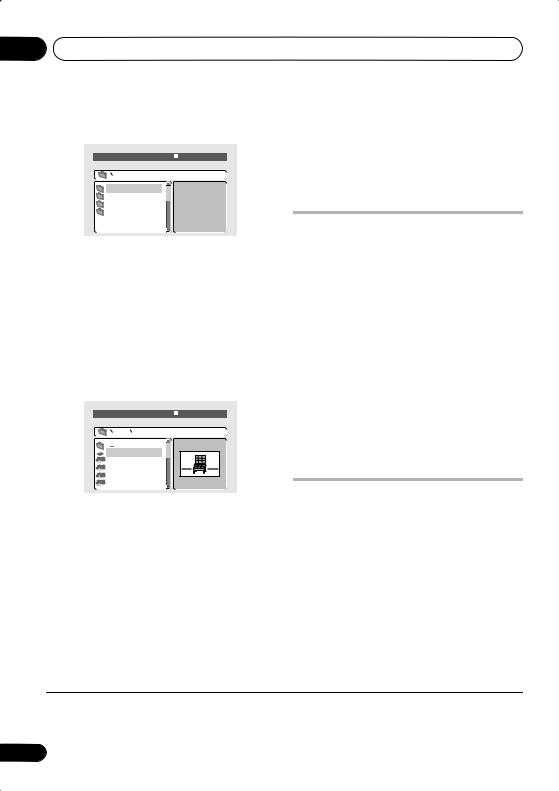
05 Playing discs
1 Press HOME MENU and select ‘Disc Navigator’ from the on-screen menu.
00:00/ 00:00 |
0kbps |
Folder1
Folder2
Folder3
Folder4
2 Use the cursor buttons (/ / /) and ENTER to navigate.
Use the cursor up/down buttons (/) to move up and down the folder/file list.
Use the cursor left button ( ) to return to the parent folder.1
Use ENTER or cursor right ( ) to open a highlighted folder.
•When a JPEG file is highlighted, a thumbnail image is displayed on the right.
00:00/ 00:00 |
0kbps |
Folder2
 File1
File1
File2
File3
File4
File5
 Tip
Tip
•To play the contents of the whole disc rather than just the current folder, exit the Disc Navigator and start playback using
the (play) button.
Looping a section of a disc
The A-B Repeat function allows you to specify two points (A and B) within a track (CD, Video CD/Super Video CD) or title (DVD) that form a loop which is played over and over.
1During playback, press HOME MENU and select ‘Play Mode’.
2Select ‘A-B Repeat’.2
3Press ENTER on ‘A(Start Point)’ to set the loop start point.
4Press ENTER on ‘B(End Point)’ to set the loop end point.
After pressing ENTER, playback jumps back to the start point and plays the loop.
5To resume normal playback, select ‘Off’.
Using repeat play
3 To play the highlighted track or DivX video file or display the highlighted JPEG file, press ENTER.
•When a WMA/MP3 or DivX video file is selected, playback begins from that file, and continues until the end of the folder.
•When a JPEG file is selected, a slideshow begins, starting with that file, and continues to the end of the folder.
In addition to various repeat play options, it’s also possible to use repeat play together with program play (see Creating a program list on page 21).
1During playback, press HOME MENU and select ‘Play Mode’.
2Select ‘Repeat’ then select a repeat play
option.3
If program play is active, select Program Repeat to repeat the program list, or Repeat Off to cancel.
 Note
Note
1You can also do this by going to the ‘..’ folder at the top, then pressing ENTER.
2You can’t use A-B Repeat play with WMA/MP3 or DivX video discs.
3You can’t use repeat play with WMA/MP3 discs.
20
En

Playing discs |
05 |
•For DVD discs, select Title Repeat,
Chapter Repeat or Repeat Off.
•For CDs and Video CD/Super VCDs, select
Disc Repeat, Track Repeat or Repeat Off.
•For DivX video discs, select Title Repeat
(or Repeat Off).
 Tip
Tip
•You can also use the REPEAT button on the remote to select a repeat play option. The repeat modes available are the same as those from the Play Mode menu.
Using random play
Use this function to play titles or chapters (DVD-Video) or tracks (CD and Video CD/Super
VCD) in a random order.1
1During playback, press HOME MENU and select ‘Play Mode’.
2Select ‘Random’ then select an option.
•For DVD discs, select Random Title,
Random Chapter or Random Off.
•For CDs and Video CD/Super VCDs, select On or Off to switch random play on or off.
 Tip
Tip
•Use the following controls during random play:
Button |
What it does |
Selects a new track/title/chapter at random.
Button |
What it does |
Returns to the beginning of the current track/title/chapter; further presses select another random track/title/chapter.
•You can also use the RANDOM button on the remote to select a random play mode. The random modes available are the same as when choosing from the Play Mode menu. Press ENTER to start random play.
•Random play remains in effect until you select Random Off from the random play menu options.
Creating a program list
This feature lets you program the play order of titles/chapters/tracks on a disc.2
Using the OSD
1During playback, press HOME MENU and select ‘Play Mode’.
2Select ‘Program’ then select ‘Create/Edit’ from the list of program options.
3Use the cursor buttons and ENTER to select a title, chapter or track for the current step in the program list.
For a DVD disc, you can add a title or a chapter.
•For a CD or Video CD/Super VCD, select a track to add to the program list.
After pressing ENTER to select the title/ chapter/track, the step number automatically moves down one.
4 Repeat step 3 to build up a program list.
A program list can contain up to 24 steps.
Español Nederlands Italiano Français Deutsch English
 Note
Note
1• You can set the random play option when a disc is playing or stopped. However, you can't use random play together with program.
•You can’t use random play with VR format DVD-RW discs, WMA/MP3 discs, DivX video discs, or while a DVD disc menu is being displayed.
2You can’t use Program play with VR format DVD-RW discs, WMA/MP3 discs, DivX video discs, or while a DVD disc menu is being displayed.
21
En

05Playing discs
•You can insert steps by just highlighting the position where you want the new step to appear and entering a title/chapter/track number.
•To delete a step, highlight it and press
CLEAR.
5 To play the program list, press (play).
Program play remains active until you turn off program play (see below), erase the program list (see below), eject the disc or switch off.
 Tip
Tip
•Use the following controls during program play:
Button |
What it does |
HOME Save the program list and exit MENU without starting playback.
Skip to the next step in the program list.
Other functions available from the program menu
There are a number of other options in the program menu in addition to Create/Edit.
•Playback Start – Starts playback of a saved program list
•Playback Stop – Turns off program play, but does not erase the program list
•Program Delete – Erases the program list and turns off program play
Using the front panel display
Even though the OSD is available for CDs, the front panel display provides information to make a program list easily. If a disc is playing, stop it first.
22
1 Press PROGRAM.
You’re prompted to enter a track for the first step in the program list.
C D |
P G M 0 0 |
|
0 0 : 0 0 |
2Use the number buttons to select a track, then press ENTER.
If you make a mistake, press CLEAR to delete the last (most recently) programmed track.
3Repeat step 2 to build up a program list.
A program list can contain up to 24 steps.
4 To play the program list, press (play).
• Program play remains active until you press (stop), clear the playlist (see tip above), eject the disc or switch off the player.
Searching a disc
You can search DVD discs by title or chapter number, or by time; CDs and Video CD/Super VCDs by track number or time; DivX video discs by time.
1Press HOME MENU and select ‘Play Mode’.
2Select ‘Search Mode’.
The search options that appear depend on the kind of disc loaded.
3Select a search mode.
•The disc must be playing in order to use time search.
4Use the number buttons to enter a title, chapter or track number, or a time.
•For a time search, enter the number of minutes and seconds into the currently playing title (DVD/ DivX video) or track (CD/ Video CD/Super VCD) you want playback to resume from. For example, press 4, 5, 0, 0 to have playback start from 45 minutes into the disc. For 1 hour, 20 minutes and 30 seconds, press 8, 0, 3, 0.
En

Playing discs |
05 |
5 Press ENTER to start playback.
Switching subtitles
Some DVD discs and DivX video discs have subtitles in one or more languages; the disc box will usually tell you which subtitle languages are available. You can switch
subtitle language during playback.1
• Press SUBTITLE repeatedly to select a subtitle option.
•To set subtitle preferences, see Language settings on page 32.
•See Displaying DivX subtitle files on page 38 for more on DivX subtitles.
2 Use the cursor buttons to change the zoomed area.
You can change the zoom factor and the zoomed area freely during playback.4
Switching camera angles
Some DVD discs feature scenes shot from two or more angles—check the disc box for details.
When a multi-angle scene is playing, a  icon appears on screen (this can be switched off if you prefer—see Display settings on page 32).
icon appears on screen (this can be switched off if you prefer—see Display settings on page 32).
• During playback (or when paused), press ANGLE to switch angle.
Switching language / audio channels
When playing discs recorded with dialog in two or more languages, or with dual-mono audio2 you can switch these during playback.3
• Press AUDIO repeatedly to select an audio language option.
•To set audio language preferences, see
Language settings on page 32.
Zooming the screen
Using the zoom feature you can magnify a part of the screen by a factor of 2 or 4, while watching a DVD, DivX video title or Video CD/ Super VCD or playing a JPEG disc.
1 During playback, use the ZOOM button to select the zoom factor (Normal, 2x or 4x).
Displaying disc information
Various track, chapter and title information can be displayed on-screen during playback.
• To show/switch/hide the information displayed, press DISP/CHARA repeatedly.
Limited disc information also appears in the front panel display. Press DISP/CHARA to change the displayed information.
Español Nederlands Italiano Français Deutsch English
 Note
Note
1Some discs only allow you to change subtitle language from the disc menu. Press TOP MENU or DVD MENU to access.
2Some Super VCDs have two soundtracks. With these discs you can switch between the two soundtracks as well as individual channels in each.
3Some discs only allow you to change audio language from the disc menu. Press TOP MENU or DVD MENU to access.
4• Since DVD, Video CD/Super VCD, DivX video title and JPEG pictures have a fixed resolution, picture quality will deteriorate, especially at 4x zoom. This is not a malfunction.
•If the navigation square at the top of the screen disappears, press ZOOM again to display it.
23
En

06 More tuner features
Chapter 6
More tuner features
Memorizing stations
You can save up to 30 station presets so that you always have easy access to your favorite stations without having to tune in manually
each time.1
Manually saving station presets
1 Tune to an AM or FM radio station.
For the FM band, select mono or auto-stereo reception as necessary. This setting is saved along with the preset.
2Press SYSTEM SETUP, use / to choose ‘Tuner Setup’ then press ENTER.
3Use / to choose ‘ST. Memory’ then press ENTER.
4Use / to select the station preset you want then press ENTER.
Automatically saving station presets
1Press SYSTEM SETUP, use / to choose ‘Tuner Setup’ then press ENTER.
2Use / to choose ‘Auto Preset’ then press ENTER.
Auto tuning starts in the FM band, stopping when a strong signal is received.
3When auto tuning stops at a station, press ENTER to save the station as a preset, or press CLEAR to continue without saving.
Auto tuning resumes. After the FM band is finished, auto tuning continues in the AM
band. Press (stop) anytime to exit.
Auto tuning stops automatically after the AM band is finished, or after the limit of 30 presets has been reached. When this happens, the tuner automatically switches to preset ST-1.
Naming station presets
You can name station presets for easy identification.2
1Press FM/AM repeatedly to select the station preset mode.
The display shows ST.
2Use the ST +/– buttons to select a station preset.3
3Press SYSTEM SETUP, use / to choose ‘Tuner Setup’ then press ENTER.
4Use /to choose ‘ST. Name’ then press
ENTER.
5Use / and ENTER to input up to 11
characters.3
•Press DISP/CHARA to switch between uppercase and lowercase letters. Press MARK to select symbols.
•If you make a mistake, press to go back to the character and / to change it.
•Press CLEAR to delete a character or (stop) anytime to exit without saving.
6 Press SYSTEM SETUP when you’re done.
 Note
Note
1If the system is unplugged, saved stations will remain for several days, after which you’ll have to save them again.
2Press DISP/CHARA to switch between the station name and frequency displays.
3You can also use the number/character buttons to do this.
24
En

More tuner features
Listening to station presets
1Press FM/AM repeatedly to select the station preset mode.
The display shows ST.
2Use the ST +/– buttons to select a station preset.1
Improving poor FM reception
If you’re listening to an FM station in stereo but the reception is weak, you can improve the sound quality by switching to mono.
1Tune to an FM radio station then press SYSTEM SETUP.
2Use / to choose ‘Tuner Setup’ then press ENTER.
3Use / to choose ‘FM Mode’ then press ENTER.
4Use / to select ‘Mono’ then press
ENTER.
The mono indicator ( ) lights when the tuner is in mono reception mode.
) lights when the tuner is in mono reception mode.
Select Auto above to switch back to autostereo mode (the stereo indicator ( ) lights when receiving a stereo broadcast).
) lights when receiving a stereo broadcast).
 Note
Note
1 You can also use the number/character buttons to do this.
06
Español Nederlands Italiano Français Deutsch English
25
En

07 Singing karaoke
Chapter 7
Singing karaoke
Singing karaoke
Using the karaoke features you can plug in a microphone and mix the sound of your own voice with a backing track. The backing track can be anything you like, from a song on the radio, to a dedicated DVD karaoke disc. Adjust the microphone level relative to the backing track.
MIC
MIN
 MAX
MAX
VOL |
MAIN |
SUB |
4To change the mix (CD or Video CD/Super VCD only), press KARAOKE.
Press to switch between these options:
•Vocal Fade – Vocals in the backing track are partially eliminated using EQ.
•L Ch – Left channel only. Use for tracks that have a vocal recorded in the right channel.
•R Ch – Right channel only. Use for tracks that have a vocal recorded in the left channel.
•L + R Ch – Use to put a single-channel vocal track into the center of the mix.
•Off – Switches the Karaoke mode off.
5Play the backing track.
6Adjust the MIC VOL knob to get the sound you want.
To avoid unpleasant feedback, make sure you
don’t point the microphone(s) at the speakers.2
1Set the MIC VOL knob (front panel) to minimum.
2Plug in the microphone(s).
If you’re only using one mic, plug it into the
MIC (MAIN) jack. The MIC (SUB) jack can be used only if MIC (MAIN) is also connected.
•If the microphone has an on/off switch, make sure it’s on.
3 Load a karaoke backing disc or tape.
You can also use the radio or a component connected to the auxiliary inputs as source
material for a backing track.1
7 Sing!
Changing the vocal mix
Adding some effects to the microphone mix can sometimes improve the overall sound. You can choose between three echo levels.
• To add effects to the microphone mix, press ECHO.
Pressing repeatedly switches between echo levels 1 to 3 and off.
Changing the backing track
You may want to lower or raise the pitch of the backing track to match your vocal range.
• Press KEY CONTROL or to lower or raise the pitch of the backing track.
 Note
Note
1If the front panel audio input (F. Audio In) or USB jack (USB) is selected, they must also be connected to hear any mic output.
2Depending on the microphone level, the sound of the disc may distort. If this happens, turn down the volume.
26
En

Adjusting the sound
Chapter 8
Adjusting the sound
08
English
Adjusting the bass and treble
Use the bass and treble controls to adjust the overall tone.1
1Press SOUND, use / to select ‘Tone’ then press ENTER.
2Use / to select ‘Bass’ or ‘Treble’ then press ENTER.
3Use /to adjust the sound then press
ENTER to confirm.
Using the Quiet mode
• Default setting: Off
The Quiet listening mode allows you to hear effective surround sound of movies at low volume levels.
1Press SOUND, use / to select ‘Quiet
Mode’ then press ENTER.
2Use /to select ‘On’ or ‘Off’ then press
ENTER.
Boosting the bass level
• Default setting: Off
If you want to bring up the low end for certain kinds of music or sound sources, you can use the bass boost to do so.
Using the Sound Field Control
Depending on the source you’re listening to, you may want to use the Sound Field Control to match the source you’re listening to.
• Press SFC repeatedly to select a sound mode.
Choose between Off (TONE indicator disappears), Movie, Music, Live, Hall or Drama.
Muting the sound
Use the mute button if you need to momentarily turn off any sound coming out of
the speakers.2
• Press MUTE to switch off the volume.
To switch the sound back on, adjust the volume or press MUTE again.
Español Nederlands Italiano Français Deutsch
•Press BASS BOOST to switch on or off.
 Note
Note
1Bass and treble adjustment is not possible with the Quiet or SFC modes.
2Muting shows in the display when an operation is prohibited because the sound is muted.
27
En

09 Using the timer
Chapter 9
Using the timer
Setting the wake-up timer
Use the wake-up timer to set the system to switch on at any time and start playing whatever source you want.
Turning the wake-up timer on/off
If you have already set the wake-up timer, you can switch it on/off by selecting Timer On or Timer Off in step 4 above (press ENTER).
 Important
Important
•The clock must be set to the correct time for the wake-up timer to work properly (see
Setting the clock on page 15).
1 Select the source you want played.
For example, press FM/AM to select the radio as your source.
2Prepare the source and set the volume.
For example, tune in the radio station you want to wake up to. Adjust the volume as necessary.
3Press TIMER twice, use / to select
‘Wake-Up’ then press ENTER.
4Use /to select ‘Timer Edit’ then press
ENTER.
5Set the switch-on time.
Use / to set the hour, then press ENTER. Set the minute in the same way, pressing ENTER when you’re done.
6 Set the switch-off time.
Set as above, pressing ENTER when done. The wake-up indicator lights, and the switch-on, switch-off times, the function (DVD/CD, etc.) and volume are confirmed in the display.
7 Switch the system into standby mode.
The wake-up timer will not work if the system is left on!
•You can check the timer settings in standby by pressing TIMER twice.
Setting the sleep timer
The sleep timer switches off the system after a specified time so you can fall asleep without worrying about it.
 Important
Important
•If you set the sleep timer while either the wake-up timer is active, the earlier switch off time takes priority.
1Press TIMER twice, use / to select
‘Sleep’ then press ENTER.
2Use / to select a switch-off time then press ENTER.
Choose between the following options:
•Auto – Switches off automatically after the currently playing CD or Video CD has finished.1
•90 min – Switches off after 90 minutes
•60 min – Switches off after an hour
•30 min – Switches off after 30 minutes
•Off – Cancels the sleep timer
3To check how much time is left, repeat step 1.
The remaining time is displayed momentarily.
 Note
Note
1 Sleep Auto will not work with Video CD/Super VCDs during PBC playback or CDs in repeat play.
28
En
